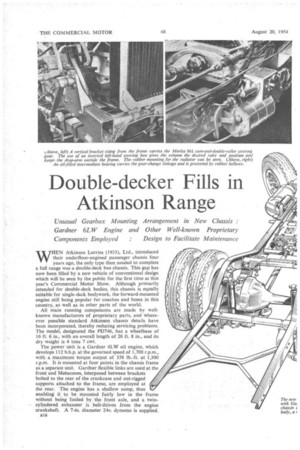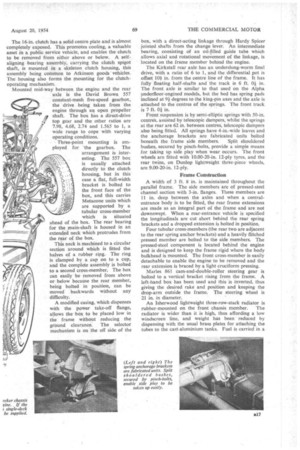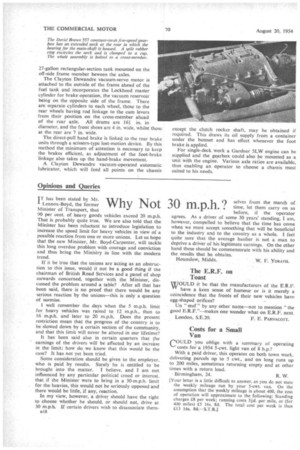Double-decker Fills in Atkinson Range
Page 50

Page 51

Page 52

If you've noticed an error in this article please click here to report it so we can fix it.
'Unusual Gearbox Mounting Arrangement in New Chassis : Gardner 6LW Engine and Other Well-known Proprietary Components Employed : Design to Facilitate Maintenance
WHEN Atkinson Lorries (1933), Ltd., introduced their underfloor-engined passenger chassis four years ago, the only type then needed to complete a full range was a double-deck bus chassis. This gap has now been filled by a new vehicle of conventional design which will be seen by the public for the first time at this year's Commercial Motor Show. Although primarily intended for double-deck bodies, this chassis is equally suitable for single-deck bodywork, the forward-mounted engine still being popular for coaches and buses in this country, as well as in other parts of the world.
All main running components are made by wellknown manufacturers of proprietary parts, and whereever possible standard Atkinson . chassis details have been incorporated, thereby reducing servicing problems. The model, designated the PD746, has a wheelbase of 16 ft. 6 in., with an overall length of 26 ft. 8 in., and its dry weight is .4 tons 7 cwt.
The power unit is a Gardner 6LW oil engine, which develops 112 b.h.p. at the governed speed of 1,700 r.p.m., With. a. maximum torque output of 358 lb.-ft. at 1,300 r.p,m. It is mounted at four points in the chassis frame as a separate unit. Gardner flexible links are used at the front. and Metacones, interposed between brackets bolted to the rear of the crankcase and out-rigged supports attached -to the frame, are employed at the rear. The -.engine has .a. shallow sump, thus enabling it to be mounted fairly low in the frame without being fouled by. the front axle, and a twincylindered exhauster is • belt drivenfrom the engine crankshaft. A 7-in. diameter 24v. dynamo is supplied.
B16 The 16-in, clutch has a solid centre plate and is almost completely exposed. This promotes cooling, a valuable asset in a public service vehicle, and enables the clutch to be removed from either above or below. A selfaligning bearing assembly, carrying the clutch spigot shaft, is mounted in a skeleton clutch housing, this assembly being common to Atkinson goods vehicles. The housing also forms the mounting for the clutchoperating mechanism.
Mounted mid-way between the engine and the rear axle is the David Brown 557 constant-mesh five-speed gearbox, the drive being taken from the engine through an open propeller shaft. The box has a direct-drive top gear and the other ratios are 7.98, 4.68, 2.74 and 1.565 to 1, a wide range to cope with varying operating conditions.
Three-point mounting is employed for the gearbox. The arrangement is interesting. The 557 box is usually attached directly to the clutch housing, but in this case a flat, full-width bracket is bolted to the front face of the box, and this carries Metacone units which are supported by a tubular cross-member which is situated ahead of the box. The rear bearing for the main-shaft is housed in an extended neck which protrudes from the rear of the box.
This neck is machined to a circular section around which is fitted the halves of a rubber ring. The ring is clamped by a cap on to a cup, and the complete assembly is bolted to a second cross-member. The box can easily be removed from above or below because the rear member, being bolted in position, can be moved backwards without any difficulty.
A modified casing, which dispenses with the power take-off flange, allows the• box to be placed low in the frame without reducing the ground clearance. The selector mechanism is on the off side of the box, with a direct-acting linkage through Hardy Spicer jointed shafts from the change lever. An intermediate bearing, consisting of an oil-filled guide tube which allows axial and rotational movement of the linkage, is located on the frame member behind the engine.
The Kirkstall rear axle has an undersiung-worm final drive, with a ratio of 6 to 1, and the differential pot is offset 10i in. from the centre line of the frame. It has fully floating half-shafts and the track is 6 ft. Oi in. The front axle is similar to that used on the Alpha pnderfloor-engined models, but the bed has spring pads inclined at 9 degrees to the king-pin axes and the axle is attached to the centres of the springs. The front track is 7 ft. Oi in.
Front suspension is by semi-elliptic springs with 50-in. centres, assisted by telescopic dampers, whilst the springs at the rear are 62 in. between centres; telescopic dampers also being fitted. All springs have 4-in.-wide leaves and the anchorage brackets are fabricated units bolted beneath the frame side members. Split shouldered bushes, secured by pinch-bolts, provide a simple means for taking up side play when wear occurs. The front wheels are fitted with 10.00-20-in. 12-ply tyres, and the rear twins, on Dunlop lightweight three-piece wheels, are 9.00-20-in. 12-ply.
Frame Construction A width of 3 ft. 8 in. is maintained throughout the parallel frame. The side members are of pressed-steel channel section with 3-in. flanges. These members are 11 in. deep between the axles and when a centralentrance body is to be fitted, the rear frame extensions are made as an integral part of the frame and are not downswept. When a rear-entrance vehicle is specified the longitudinals are cut short behind the rear spring brackets and a dropped extension is bolted in position.
Four tubular cross-members (the rear two are adjacent to the rear spring anchor brackets) and a heavily flitched pressed member are bolted to the side members. The pressed-steel component is located behind the engine and is designed to keep the frame rigid where the body bulkhead is mounted. The front cross-member is easily detachable to enable the engine to be removed and the rear extension is braced by a light cruciform pressing.
Marles 861 cam-and-double-roller steering gear is bolted to a vertical bracket rising from the frame. A left-hand box has been used and this is inverted, thus giving the desired rake and position and keeping the drop-arm outside the frame. The steering wheel is 21 in. in diameter.
An Isherwood lightweight three-row-stack radiator is rubber-mounted on the front chassis member. The radiator is wider than it is high, thus affording a low windscreen line, and weight has been reduced by dispensing with the usual brass plates for attaching the tubes to the cast-aluminium tanks. Fuel is carried in a
27-gallon rectangular-section tank mounted on the off-side frame member beween the axles.
The Clayton Dewandre vacuum-servo motor is attached to the outside of the frame ahead of the fuel tank and incorporates the Lockheed master cylinder for brake operation, the vacuum reservoir being on the opposite side of the frame. There are separate cylinders to each wheel, those to the rear wheels having rod linkage to the cam levers from their position on the cross-member ahead of the rear axle. All drums are 161 in. in diameter, and the front shoes are 4 in. wide, whilst those at the rear are 7 in. wide.
The direct-pull hand brake is linked to the rear brake units through a scissors-type lost-motion device. By this method the minimum of attention is necessary to keep the brakes efficient, as adjustment of the foot-brake 'linkage also takes up the hand-brake movement. A Clayton Dewandre vacuum-operated automatic lubricator, which will feed all points on the chassis except the clutch rocker shaft, may be obtained if required. This draws its oil supply from a container under the bonnet and has effect whenever the foot brake is applied. For single-deck work a Gardner 5LW engine can be supplied and the gearbox could also be mounted as a unit with the engine. Various axle ratios are available, thus enabling an operator to choose a chassis most suited to his needs.




































































































